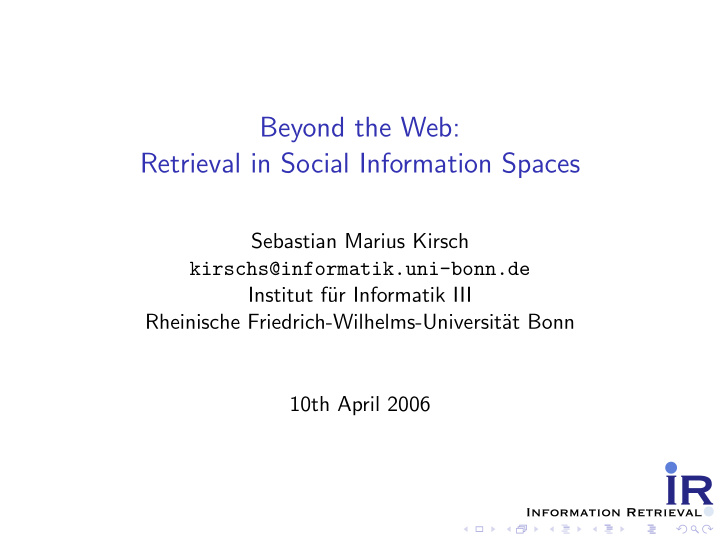



Beyond the Web: Retrieval in Social Information Spaces Sebastian Marius Kirsch kirschs@informatik.uni-bonn.de Institut f¨ ur Informatik III Rheinische Friedrich-Wilhelms-Universit¨ at Bonn 10th April 2006
Outline Social Information Spaces Retrieval with Social Networks An Algorithm for Social Retrieval Evaluation Conclusion
Social Information Spaces ◮ ‘We live, work, play in social spaces – both online and offline.’ [Lueg and Fisher, 2003] ◮ ‘Man is a social animal.’ ◮ online group interaction predates the internet (email mailing lists, Usenet) ◮ today: surge in web-based social software ◮ wikis (Wikipedia, . . . ) ◮ blogs (LiveJournal, Blogspot, MySpace, . . . ) ◮ social networking platforms (Friendster, orkut, openBC, . . . ) ◮ ‘social’ bookmarking (del.icio.us, simpy, . . . ) ◮ more added every day ◮ realize vision of the ‘read-write web’ [Lawson, 2005]
Beyond the web? ◮ web is a document-centric system ◮ documents authored individually, joined by hyperlinks ◮ web is just a user interface for social information spaces ◮ underlying information space lives in a database ◮ social information spaces: users, their documents, and relations between them. ⇒ analyze the information space directly for information retrieval
Information Spaces
Information Spaces
Information Spaces
Information Spaces
Information Spaces social network documents
Information Spaces social network documents
Web retrieval vs. social retrieval ◮ web retrieval ◮ content and keywords not sufficient to determine relevant pages ◮ algorithms analyse hyperlink structure ◮ try to infer authority of a page from the pages linking to it ◮ most prominent example: PageRank [Page et al., 1999] ◮ social networks ◮ graph-based retrieval, like web retrieval ◮ social networks share many statistical properties with the web graph (small world, power-law distribution, clustering) ⇒ apply techniques from web retrieval ⇒ use PageRank as authority measure on social network
PageRank as an authority measure for social networks? PageRank scores extracted from coauthorship network of 25 years of sigir proceedings, normalized, with a teleportation probability of ǫ = 0 . 3: rank name PageRank 1. Bruce W. Croft 7.929 2. Clement T. Yu 4.716 3. James P. Callan 4.092 4. Norbert Fuhr 3.731 5. Susan T. Dumais 3.731 6. Mark Sanderson 3.601 7. Nicholas J. Belkin 3.518 8. Vijay V. Raghavan 3.303 9. James Allan 3.200 10. Jan O. Pedersen 3.135
PageRank-based algorithm for social ir 1. Extract authors and social network from corpus. 2. Compute PageRank scores r i for authors in the social network. 3. Assign PageRank scores to documents: r d ← r i if i is author of d . 4. For a query q , determine set of relevant documents D q and relevance scores score( q , d ) for d ∈ D q 5. Combine PageRank scores with relevance scores: r d · score( q , d ) 6. Sort D q by r d · score( q , d ) and return it.
Evaluation ◮ task: known-item retrieval ◮ metrics: average rank and inverse average inverse rank ◮ compare performance with performance of a baseline method ◮ mailing-list archive (44108 messages from 2000–2005, 1834 different email addresses) ◮ semi-automatic method for choosing query terms and known items ◮ results for expert searcher ◮ average rank increases (up to 70%) ◮ up to 25% decrease in IAIR ◮ better results for larger collections ◮ results for novice searcher are inconclusive ◮ increase in both average rank and IAIR for larger collections ◮ no trend as regards collection size
Conclusion ◮ social networks are an integral part of information retrieval ◮ social network analysis can lead to significant performance improvements ◮ further research is necessary ◮ evaluation ◮ application to different domains ◮ perhaps combine with community approaches? ◮ privacy implications? ◮ rise of social software will necessitate retrieval algorithms using social networks ◮ generate tangible advantages from using social software
Questions? Feedback?
Thank you very much for listening! slides for this talk are available at http://www.sebastian-kirsch.org/moebius/docs/ ecir2006-slides.pdf
Beyond the Web: Retrieval in Social Information Spaces Sebastian Marius Kirsch kirschs@informatik.uni-bonn.de Institut f¨ ur Informatik III Rheinische Friedrich-Wilhelms-Universit¨ at Bonn 10th April 2006
Mark Lawson. Berners-Lee on the read/write web. broadcast by Newsnight on BBC Two, August 2005. URL http://news.bbc.co.uk/1/hi/technology/4132752.stm . Interview with Tim Berners-Lee. Christopher Lueg and Danyel Fisher, editors. From Usenet to CoWebs. Interacting with social information spaces . Springer, 2003. ISBN 1-85233-532-7. Lawrence Page, Sergey Brin, Rajeev Motwani, and Terry Winograd. The PageRank citation ranking: Bringing order to the Web. Technical report, Stanford University, November 1999. URL http://dbpubs.stanford.edu:8090/pub/1999-66 .
Recommend
More recommend